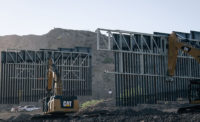In a July 31 ruling, the U.S. Supreme Court said construction of the U.S.-Mexico border wall using funds transferred from military pay and pension accounts can continue, with justices letting stand its earlier ruling that temporarily allowed barrier work to move forward while it considers the merits of opponents' case against it.
Opposition groups argued that because the $2.5 billion in diverted U.S. Defense Dept. funds would be spent and wall construction completed before issues they raised against the funding transfer is decided by the high court, that justices should allow a lower court ruling that stopped building work to stand.
A separate case pending before a federal appeals court involves $3.6 billion in military funds diverted to the wall from other DOD construction programs after President Donald Trump declared a national emergency to gain the money when Congress refused to authorize funding.
The wall contractors U.S. Army Corps of Engineers chose in 2019 include BFBC, Bozeman, Mont.; Texas Sterling Construction, Houston; Bristol Construction Services, Anchorage Alaska; Burgos Group, Albuquerque; and a Gibraltar-Cadell joint venture, Montgomery, Ala.
Also selected were Fisher Sand & Gravel, Dickinson, N. D.; Southwest Valley Constructors Co., an Albuquerque unit of Kiewit; Randy Kinder Excavating, Dexter, Mo.; and Martin Brothers Construction, Sacramento.
The list also includes SLS, Galveston, Texas; a joint venture of Posillico Civil and Coastal Environmental Group, Farmingdale, N.Y., and CJW, Santa Ana, Calif.
“Every lower court to consider the question has ruled President Trump’s border wall was illegal. We’ll be back before the Supreme Court soon to put a stop to Trump’s xenophobic border wall once and for all,” Dror Ladin, an attorney for the American Civil Liberties Union, said in a statement, adding that the group will seek removal “of every mile of unlawful wall built.”
The court case’s history is complicated.
A federal district court in California last year ruled that Trump’s attempt to circumvent Congress and use the military pay and pension funds for wall construction was illegal. The Supreme Court ruled, however, that construction activity could continue temporarily while it considered the merits of the case.
In June, the federal court of appeals in San Francisco agreed with the district court that the diversion of funds was illegal and an overreach of executive authority.
ACLU, representing the Sierra Club and the Southern Border Communities Coalition, asked the high court to lift its order last year allowing construction to continue. The court’s conservative majority refused to do so, without comment.
A court minority dissented, which included Justice Stephen Breyer, who said that the group would have let the district court’s order to stop construction stand until case merits could be decided.
“The court’s decision to let construction continue, may operate in effect, as a final judgment,” said Breyer, who wrote the dissent in the 5-4 decision.
The fate of the additional $3.6 billion in diverted military funds was declared illegal by the district court. That case is currently pending before the appeals court in San Francisco.
Congress gave the Trump administration $5 billion for wall construction, but it obtained an additional $10 billion by tapping other DOD budgets, including the $6 billion pending before the courts in these two cases.





